

The Aura of Wadi Rum
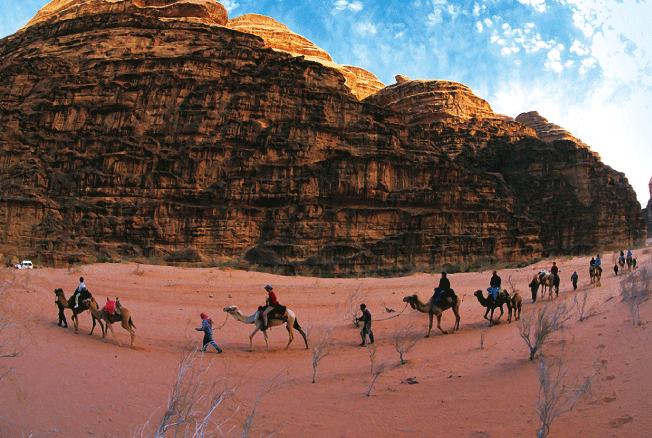 |
Lying in Jordan's south, Wadi Rum is one of the world's great escapes, nominated as one of UNESCO's World Heritage sites, a protected area of 720 square kilometers of dramatic desert wilderness.
Its mammoth mountains of sandstone and granite rise up
in a featureless yet mesmerizing desert with its sandy valleys reaching
heights of 1700 meters or more.
By Noor Alsaleh
Its narrow canyons and fissures gorge into the mountains with ancient rock drawings stamped by the desert people over centuries of living. Weather and time have made wonders out of the formations, creating contours, shapes and colors that are at best dazzling.
Driving from Amman to Rum and witnessing the bare arid lands, one wonders what is so special about a place that many from the world-over come to visit. What makes it a special desert, why should anyone leave his warm bed and clean sheets and sleep in the middle of nowhere, what makes it a place where couples from abroad flock to get married? 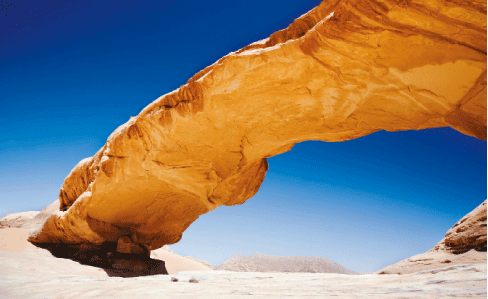
While I was writing about this place and looking through the many pictures we took of this magnificent desert, I realized nothing can really describe the aura and feeling of being there in the middle of a desert surrounded by the vast stunning mountains. No picture can really depict the scene as the colors of the landscape changes as the sun sets in. Nothing can describe the taste of the Bedouin tea brewed on a fire over the sounds of the Shabbabah in the heart of the desert where you can hear the sound of a whisper. The pictures only give an inkling of the serene emptiness, but not the distant mutter of traffic and the sound of the prayers echoing down the canyon.
Not so many impressions have been communicated to me by the foreigners who were with us visiting the place while we watched the sun rise after a long dawn trip on our buggies inside the desert. They were all in silence, enjoying a moment they left their cities for, a moment for them not to be repeated again back home. They came from everywhere, Singapore, Italy, Austria, United States, England, and many other places, all willing to go through a journey that is not easy for a city dweller especially as there are no hotels there. In Wadi Rum, camping is your only option.
We had the option of choosing a campsite and sleep in one of the site's permanently pitched bell tents, or sleep in the open under the starlit sky. Or we could have gone through a real desert experience and camp wild almost anywhere. However, we chose the Bait Ali Camp as we were told it offers all.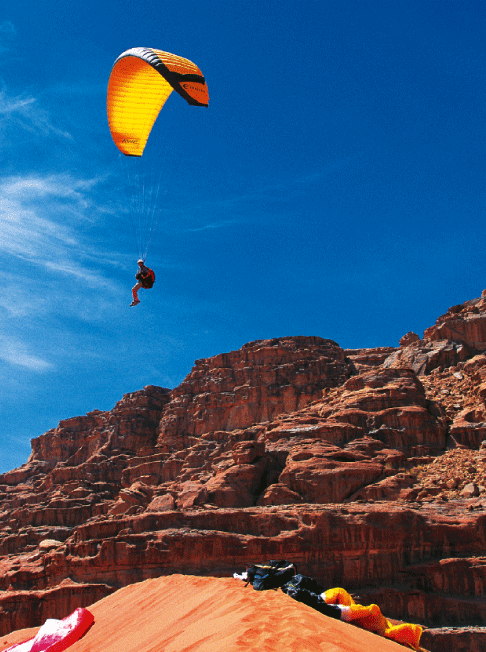
Bait Ali turned out that to be an experience in itself. Located in the heart of Wadi Rum, Bait Ali is a home away from home, easily accessed from the highway (around 55 kilo from Aqaba). Its story goes back to the year 2000 when two desert lovers decided to put an idea they had into practice, but who probably never thought it would flourish in such a big way some day.
They started with just one tent that got bigger and bigger, with other tents added until one day they stretched over a span of 100 donums in the heart of Wadi Rum. Tahseen Shinaco (Abu Amer) and his English wife Susan, hand-build for themselves a second home, offering visitors a lifetime experience.
Built in the Bedouin Arab tradition, Bait Ali blends naturally into its desert surroundings and is an environment-friendly campsite, lit by hand-made lanterns and candles. The camp provides clean, modern facilities yet keeps the essence of a Bedouin/Arabian camp both in its architecture, layout and homely atmosphere. Everything is handmade, and designed by Abu Amer who is a civilian pilot and maritime engineer by profession and training. The raw materials were taken from the sand and rocks of the area, giving it the authentic look. Along with his wife and dedicated team, a living colony inside the featureless desert was built, allowing you for a moment to forget that you have traveled far from home.
There you can stay in a tent with mattresses and blankets, or take a chalet that has modern hot showers and toilets. The features were built in response to requests from incoming tourists. Many come but preferred to stay in comfortable chalets while embarking on a journey deep inside by jeep safari to live the desert experience. At Bait Ali you can rent a 4 by 4 wheel-drive that takes you to visit canyons and rock inscriptions which have been made by the Nabateans and the Thumudians over 2000 years ago.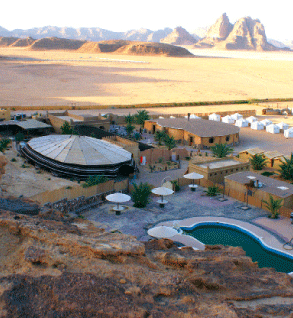
Riding on the back of the jeeb and watching the rock formations standing majestically upwards in the wilderness is awe-inspiring, making you believe you are on another planet. Our Bedouin guide dropped us on top of one mountain to watch the sunset. We lay there on the soft sand witnessing the sun's reflections of the changing colours of the mountains, deepening from rose and white to pink, purple and orange. The call for Maghreb prayer was heard from a distance, breaking the silence. Amidst the calming emptiness and in front of the magnificence of the desert scenery, man is dwarfed to insignificance.
The night in this land of tranquility brings new delights as you lay back by the camp fire and gaze at the stars shining with bright intensity in the pollutionless skies. Every night Bait Ali's large modern kitchen offers good wholesome Arab food in their traditional Bedouin tent, accompanied by eastern and Bedouin music as well as traditional dancing. Most visitors would ask for Zerb. Next day, a chorus of bird song woke us up at dawn. We decided to try the quad bikes for a spectacular ride at dawn. The two-hour magical drive made us simply forget the sleepless night we had. One tourist from Singapore gleed: "He is going to make us Bedouin tea," referring to the guide. At times we tend to forget to enjoy the taste of our Bedouin tea that we'd wait for a foreigner to remind us of its delicious taste. The tea was made over a brewing fire after our long fun-ride inside the desert. Our guide Munther, who knows Rum by heart, chose the shade of one of the over-towering mountains for a respite. There, over the sound of the Shababeh and the boundless empty spaces, the tea tasted differently.
Bait Ali also offers horse and camel riding, hot-air ballooning and land sailing which we didn't have the chance to try out for the tight schedule. A few months ago, Bait Ali hosted Lebanese singer Fares Karam in their newly amphitheatre built to host more than 7000 people. Starting in 2011, there will be a Bait Ali Festival hosting famous singers and musicians from all over, Jordan and abroad. It is also the only camp in Rum with a swimming pool, and has an engraved stairway inside a mountain that takes you up for a great view. And there is also wi-fi and mobile connection.
There is an ecotourism feel about the camp, which Abu Amer wants to deepen through emphasizing conservation, education, traveler responsibility and active community participation. A new travel ethic is emerging to allow for the enjoyment and appreciation while allowing for the socio-economic involvement of the local people. 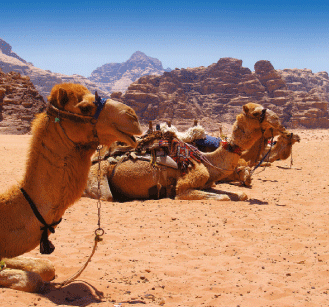
Wadi Rum is home to more than 4000 Bedouins who still maintain a relatively unchanged lifestyle that has gone on for thousands of years, whilst earning most of their income from tourism. The place is visited by climbers who find the mountain terrain unique and challenging, and gives them a unique experience they cannot get anywhere else in the world.
Arab tribes have lived here freely, roaming the deserts and mountains, amongst them were Ad, Thamud, Lihyan, Main and then the Nabataean's, the builders of ancient Petra, a city that is an hour drive away. Many people come to visit the Nabataean temple or go up to Umm Alghami, the highest mountain in Jordan, situated on the Saudi border where the Red Sea can be seen on a clear sunny day.
Many visitors come to see the place that intrigued T. E Lawrence (a British officer, better known as Lawrence of Arabia, renowned for his liaison role in the Great Arab Revolt) and why he mentioned it frequently in his writings. They come to see where Lawrence once hid his men, allowing them to relive bygone times. Wadi Rum was the place chosen to film the famous "Lawrence of Arabia" movie. In his Seven Pillars of Wisdom, T. E Lawrence describes Rum as the magnificent…vast echoing and a processional way greater than imagination—the crimson sunset burned on its stupendous cliffs and slanted ladders of hazy fire down its walled avenue…" Close to the village of Wadi Rum you can still see the house where Lawrence lived in and the spring where he used to wash. 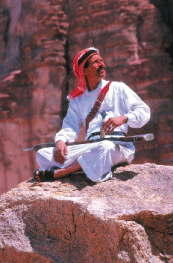
Modern-day visitors come to Rum to feel the romance of the Arabian Desert. In times of unrest, the place remains a shelter for a quiet escape. There, people meet, establish businesses, and share stories from their homes over a camp-fire. "A lot of people meet here and end up getting married, Abu Amer said. "It is a great feeling when we see them coming back with their kids to visit the place where their parents met."
No matter when you travel, the journey is worthwhile, yet the best time is in March, April and May. The warmth and hospitality and good nature of the Bedouin people cannot be summed up in an article; without them the trip wouldn't be complete.
Abu Amer and Um Amer who have been living out in the desert for the last 10 years, don't miss city life. They have become used to the quietness and peacefulness out here. They discovered themselves in the desert, learnt to be more patient, and got into situations that forced them to solve them on their own. They have gone through tough and frustrating times, but it's the challenge they seek while their two sons run their own yacht in Aqaba. "We cannot expect what will happen tomorrow, every day is a different day in the desert," they said. For them, Beit Ali is definitely not a golden palace in the desert but gives you a home and a warm welcome in an original Bedouin way.